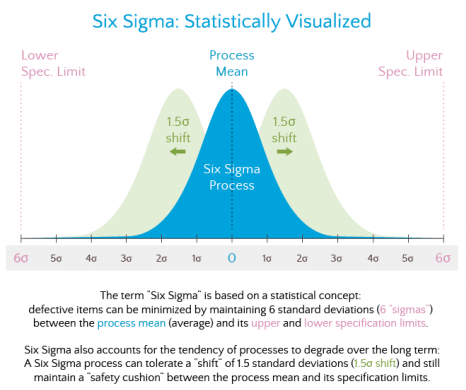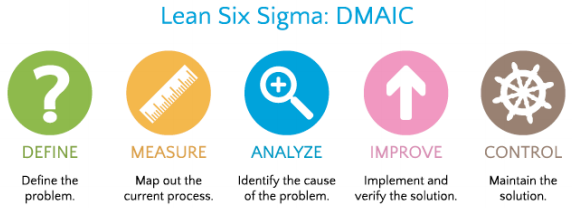Definition and Functions of Six Sigma- Six Sigma is the statistical concept where a process only produces 3.4 defects per million opportunities. Six Sigma is considered to be a goal where processes not only encounter less defects, but do so consistently (low variability). Six Sigma reduces variation to deliver products and/or services reliably.
A sigma represents 691462.5 defects per million opportunities, which translates to a percentage of non-defective outputs of only 30.854%. That would be considered poor performance. If one processes functioning at a three sigma level, this means there are 66807.2 errors per million opportunities, or delivering 93.319% non-defective outputs.
How Six Sigma Works
There are three basic elements to Six Sigma:
1. Process improvement:
The purpose of process improvement is to remove the root causes of result deficiencies in processes that already exist in the organisation. These performance deficiencies may be causing real problems for the organization, or may be preventing
it from working as efficiently and effectively as it could.
To reduce these defects a 5-step approach is used.
DMAIC
- DEFINE – a major issue is identified and a project team is formed and given the responsibility and resources for solving the problem.
- MEASURE – data that describes accurately how the process is working currently is gathered and analysed in order to produce some preliminary ideas about what might be causing the problem.
- ANALYSE – based upon these preliminary ideas, theories are generated as to what might be causing the problem and, by testing these theories, root causes are identified.
- IMPROVE – root causes are removed by means of designing and implementing changes to the offending process.
- CONTROL – new controls are designed and implemented to prevent the original problem from returning and to hold the gains made by the improvement.
2. Process design: Many a times simply improving existing processes is not enough, and, hence, new processes will need to be designed, or existing processes will need to be re-designed. There are several reasons why this could be necessary:
● An organisation may choose to replace, rather than repair, one or more of its core processes.
● An organisation discovers, during an improvement project, that simply improving an existing process will never deliver
the level of quality its customers are demanding.
● An organisation identifies an opportunity to offer an entirely new product or service.
As with process improvement, a five-step approach is used to design/re-design a process:
DMAIC
- DEFINE – identify the goals for the new process, taking into account the customer requirements.
- MATCH – develop a set of performance requirements for the new process that match these goals.
- ANALYSE – carry out an analysis of these performance requirements for the new process, and based upon this produce an outline design for the new process.
- DESIGN & IMPLEMENT – work this outline design up into a detailed design for the new process, and then implement it.
- VERIFY – make sure the new process performs as required and introduce controls to ensure it keeps performing that way.
3. Process management: Because it requires a fundamental change in the way an organisation is structured and managed, process management is often the most challenging and time-consuming part of Six Sigma.
In general, process management consists of:
● Defining processes, key customer requirements, and process “owners”.
● Measuring performance against customer requirements and key performance indicators.
● Analysing data to enhance measures and refine the process management mechanisms.
● Controlling process performance by monitoring process inputs, process operation, and process outputs, and responding quickly to problems and process variations.
)
Test Your Six Sigma Black Belt Skills By Taking Our Practice Tests on This Link.
Become Vskills Certified Six Sigma Black Belt Professional. Learn the module “Definition and Functions of Six Sigma”. Try free practice test!
Apply for Six Sigma Black Belt Certification Now!!
http://www.vskills.in/certification/Certified-Six-Sigma-Black-Belt-Professional





